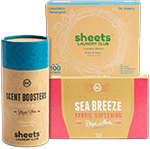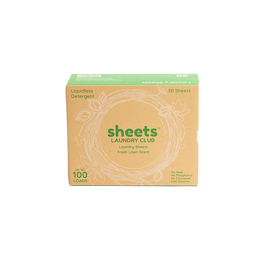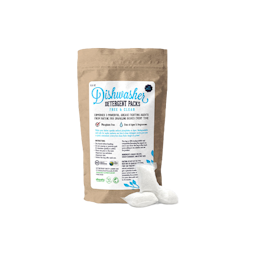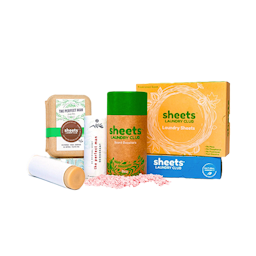Tips For How to Clean Your Sink
It’s fair to say that kitchen sinks get a lot of use throughout the week. Even if you don’t cook, you’ll still likely use your sink for a variety of chores – from washing hands and plates to watering plants. Some sinks show dirt and grime quicker than others, but in general, you should aim to clean your kitchen sink at least once a week to keep it hygienic.
However, you don’t need a bunch of fancy cleaning supplies to clean your sink! Using some everyday ingredients found in the pantry, plus a few household items, you can clean naturally and efficiently. At Sheets Laundry Club, we believe in the power of non-toxic, easy solutions to get everything, including the kitchen sink clean. Let’s take a look at some simple methods to make your sink shine.
Materials: What You’ll Need
There are a lot of harsh kitchen sink cleaners on the market, but how do you clean a sink naturally? With these all-natural ingredients and materials, of course!
- Sponge
- Microfiber cloth
- Cleaning gloves
- Baking soda
- Olive oil
- White vinegar
- Dish soap
- Laundry scent boosters
Tips For How to Clean Sink
Follow these easy methods to keep your sink clean, all the time.
Daily Cleaning Sink Rinse and Wipe
After you’ve finished cleaning the dishes, it helps to do a quick cleaning sink session to keep food and grime from accumulating during the week. In just five minutes, you can restore the hygiene of your sink and make it look fresh following a meal. Follow these quick steps:
- Put a small amount of dish soap on a sponge
- Quickly wipe down your sink with the sponge
- Rinse the sink with warm water
- Wipe dry with a clean microfiber cloth
Weekly Deep Clean
Now, when you’re ready to do a deeper clean, grab your gloves and get ready to scrub. Once a week, we recommend sprinkling baking soda over the sink and then scrubbing with a sponge. Baking soda is a mild abrasive, making it ideal as a deep sink cleaner as it clears away stains and eliminates odors without scratching your sink's finish. Work in circular motions to lift any lingering residue from the sink. Once you have finished cleaning, rinse the sink with warm water and pat it dry with a clean microfiber cloth.
Use Vinegar for Shine
White vinegar is another great sink cleaner to have in your arsenal. It naturally disinfects surfaces and leaves them shining. The only downside is the smell, but it fades quickly. To use white vinegar to clean your sink, pour it into a spray bottle and spray on top of the baking soda you’ve already applied. Wait a few minutes (enjoy the fizzing sound), then rinse the sink thoroughly with warm water to remove all traces of baking soda and vinegar. This combination helps make your sink sparkle and ensures it is completely clean, leaving a bright, polished appearance.
For Stainless Steel Sinks: Polish with Olive Oil
If you have a stainless steel sink, we recommend this additional step of polishing with olive oil. Olive oil is a natural hack to achieve a lustrous shine on stainless steel. After cleaning and drying, take a soft cloth and pour a few drops of olive oil onto it. A little goes a long way! Gently rub the oil into the stainless steel surface using circular motions to spread it across the sink evenly. This helps minimize water spots and streaks, plus the oil can act as a barrier against future smudges. Once you've covered the entire surface, buff the sink with a dry section of the cloth. No need to rinse.
Drain Maintenance
Smelly drains are a no-go in our book. To clean a drain and keep it smelling fresh, we recommend these steps:
- Pour ½ cup baking soda and ½ cup vinegar down the drain
- Let this fizz for 10 minutes
- Flush with hot water
Need a scent boost after cleaning with vinegar? Try this:
- Pour 1 tablespoon of laundry freshener beads down the drain
- Flush with hot water
- Turn on the disposal for 10 seconds
- Wait five minutes before using the tap again
Tackle Tough Limescale
Limescale buildup is common on kitchen sinks, and it’s a toughie to get rid of once it arrives. Here’s what we recommend:
- Soak a cloth in a natural sink cleaner, like white vinegar
- Wrap this cloth around the faucet
- Let sit for 10 minutes
- Wipe for a streak-free shine
This works well because vinegar is a natural acid that helps dissolve mineral deposits. If any stubborn spots are remaining, gently scrub them with a soft brush or sponge.
Preventative Care Tip: Avoid Leaving Dishes
As a preventative measure, try to avoid leaving dirty dishes and other wet items in the sink. Not only does this look unsightly, but it can lead to the development of unpleasant odors, attract insects, and create water spots or stains. The moisture can also lead to bacteria and mold growth, as well as rust. We know sometimes when you’re in a hurry, it’s easy to leave a dish or two to clean later, but on the whole, it’s best to clean it all up right away.
Sheets Laundry Club: Cleaning Up Your Life
Not only are the methods above gentle on your sink, but they are also environmentally friendly and budget-conscious! Using just a few simple ingredients in your cupboard, you can easily keep your kitchen sink clean and sparkling. For a quick recap of this article, check out this short TikTok video.
At Sheets Laundry Club, we believe a healthy home is a happy home. We’re dedicated to creating natural kitchen cleaning and laundry products to elevate your chores and life. If you’re looking to streamline your laundry routine, we make it easy with our subscription service. With our subscription boxes, you'll receive must-have household items, including our highly praised Laundry Sheets, delivered straight to your door. Begin your subscription journey today!
If you’re interested in additional home care tips, please give us a quick follow on social media or explore our website for more details on our products. As always, reach out if you have any questions on household cleaning or laundry care.



